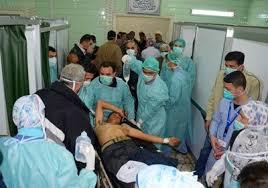Chemical weaponsRebels, not the Syrian army, fired last week’s chemical weapon: experts
Western intelligence services, analyzing the few facts known about the use of a chemical weapon near Aleppo in north Syria last week, have concluded that it was one of the rebel militias, rather than Assad government forces, which fired a “home-made” chlorine-based chemical artillery round. If the conclusion of the intelligence services is correct, it raises disturbing questions about both the capabilities of at least some rebel militias – and about their readiness to use non-conventional weapons.

Syrian medical personel treat chemical weapons victims // Source: giaoduc.net.vn
Western intelligence services, analyzing the few facts known about the use of a chemical weapon near Aleppo in north Syria last week, have concluded that it was one of the rebel militias, rather than Assad government forces, which fired the chemical artillery round.
Twenty-six people were killed by the chemical explosions, and nearly a hundred people were injured and require hospitalization.
There are four facts which have led chemical weapons experts to this conclusion:
- Most, if not all, of those killed were Syrian soldiers
- The target attacked was a Syrian army’s check point
- The Syrian government, not the rebels, was first to call for an international inquiry into the incident
- Early medical reports indicate that at least some of those killed and injured were the victims of chlorine gas. This chemical was used in the First World War (among the victims of a chlorine gas attack was Adolf Hitler, then a sergeant in the German army. He lost his sight for a few weeks but then recovered). Today’s chemical munitions use more advanced gasses, such as mustard, VX, and other nerve gasses. There were no victims who exhibited the symptoms of having been attacked by these more current chemical weapons.
Building a chlorine chemical weapon requires no more than a rudimentary knowledge of chemistry, and access to chlorine and salt solution, both commercially available.
The more demanding task is placing the chemicals in a shell and sealing it so it does not leak and injure those handling the munitions.
If the conclusion of the intelligence services is correct, it raises disturbing questions about both the capabilities of at least some rebel militias – and about their readiness to use non-conventional weapons.
The issue is even more pressing in light of the regime’s steady loss of control over Syria, and the likelihood, which is growing by the day, that the rebels might come into possession of at least some of Syria’s more sophisticated chemical weapons.
Syria has the world’s largest arsenal of chemical weapons, and the world’s largest active chemical weapons production infrastructure.
